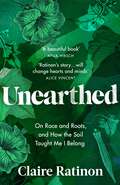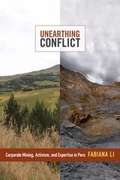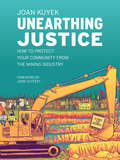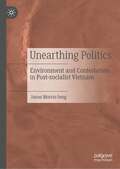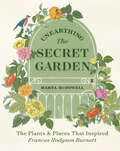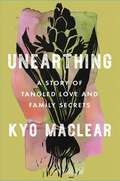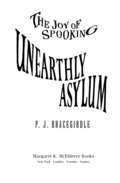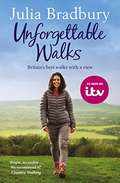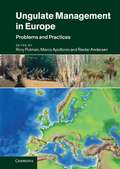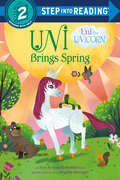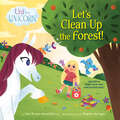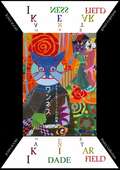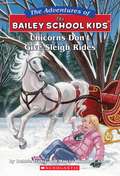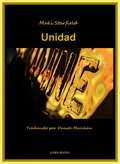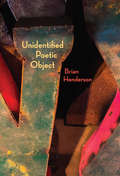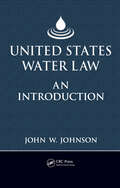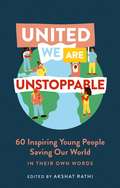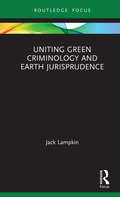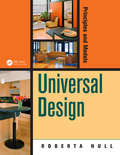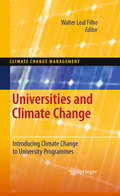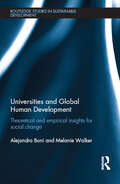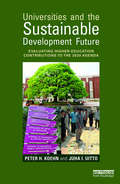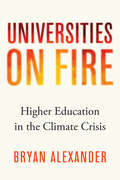- Table View
- List View
Unearthed: On race and roots, and how the soil taught me I belong
by Claire RatinonA powerful work of memoir and storytelling that will change the way we think about the natural world.Like many diasporic people of colour, Claire Ratinon grew up feeling cut off from the natural world. She lived in cities, reluctant to be outdoors and stuck with the belief that success and status could fill the space where belonging was absent. But a chance encounter with a rooftop farm was the start of a journey that caused her to rethink the life she'd been creating and her beliefs about who she ought to be. Enlivened, she turned her hand to growing food in London before finding herself yearning for a small parcel of land to call her own. Unearthed tells the story of her leaving the city for the English countryside - and her first garden - in the hope of forging a pathway towards the embrace of the natural world and a sense of belonging cultivated on her own terms.'Ratinon's story will change hearts and minds' Alice Vincent'A beautiful book about nature...I recommend it' Afua Hirsch, author of Brit(ish)
Unearthing Conflict: Corporate Mining, Activism, and Expertise in Peru
by Fabiana LiIn Unearthing Conflict Fabiana Li analyzes the aggressive expansion and modernization of mining in Peru since the 1990s to tease out the dynamics of mining-based protests. Issues of water scarcity and pollution, the loss of farmland, and the degradation of sacred land are especially contentious. She traces the emergence of the conflicts by discussing the smelter-town of La Oroya--where people have lived with toxic emissions for almost a century--before focusing her analysis on the relatively new Yanacocha gold mega-mine. Debates about what kinds of knowledge count as legitimate, Li argues, lie at the core of activist and corporate mining campaigns. Li pushes against the concept of "equivalence"--or methods with which to quantify and compare things such as pollution--to explain how opposing groups interpret environmental regulations, assess a project's potential impacts, and negotiate monetary compensation for damages. This politics of equivalence is central to these mining controversies, and Li uncovers the mechanisms through which competing parties create knowledge, assign value, arrive at contrasting definitions of pollution, and construct the Peruvian mountains as spaces under constant negotiation.
Unearthing Justice: How to Protect Your Community from the Mining Industry
by Joan KuyekThe mining industry continues to be at the forefront of colonial dispossession around the world. It controls information about its intrinsic costs and benefits, propagates myths about its contribution to the economy, shapes government policy and regulation, and deals ruthlessly with its opponents. Brimming with case studies, anecdotes, resources, and illustrations, Unearthing Justice exposes the mining process and its externalized impacts on the environment, Indigenous Peoples, communities, workers, and governments. But, most importantly, the book shows how people are fighting back. Whether it is to stop a mine before it starts, to get an abandoned mine cleaned up, to change laws and policy, or to mount a campaign to influence investors, Unearthing Justice is an essential handbook for anyone trying to protect the places and people they love.
Unearthing Politics: Environment and Contestation in Post-socialist Vietnam
by Jason Morris-JungThis book examines an important socio-political challenge to the ruling party regime in Vietnam. Vietnam has been the subject of substantial controversy and challenge to the Vietnamese party regime since market reform in the 1980s, especially since the controversy over bauxite mining in the late 2000. Using the environmental dimensions of this problem to highlight a confluence of trends disrupting the nation’s “encrusted politics”, this book open up a space for the in-depth study of the most sensitive issues, bravest activists, and most off limit struggles with the party-state in Vietnam today.
Unearthing The Secret Garden: The Plants and Places That Inspired Frances Hodgson Burnett
by Marta McDowell&“Blooming with photos, illustrations, and botanical paintings, McDowell&’s gorgeous book opens an ivy-covered door to new information about one of the world&’s most famous authors.&”—Angelica Shirley Carpenter, editor of In the GardenNew York Times bestselling author Marta McDowell has revealed the way that plants have stirred some of our most cherished authors, including Beatrix Potter, Emily Dickinson, and Laura Ingalls Wilder. In her latest, she shares a moving account of how gardening deeply inspired Frances Hodgson Burnett, the author of the beloved children's classic The Secret Garden. In Unearthing The Secret Garden, McDowell delves into the professional and gardening life of Frances Hodgson Burnett. Complementing her fascinating account with charming period photographs and illustrations, McDowell paints an unforgettable portrait of a great artist and reminds us why The Secret Garden continues to touch readers after more than a century. This deeply moving and gift-worthy book is a must-read for fans of The Secret Garden and anyone who loves the story behind the story.
Unearthing: A Story of Tangled Love and Family Secrets
by Kyo MaclearAn unforgettable memoir about a family secret revealed by a DNA test, the lessons learned in its aftermath, and the indelible power of love—for readers of Dani Shapiro&’s Inheritance and Katherine May&’s Wintering. &“Magnificent...I will never forget it.&” —Dani Shapiro, author of Inheritance &“A mind-altering and supremely generous exploration of kinship, selfhood, memory, and the roots we share across time, space and species.&” —Naomi Klein, author of This Changes EverythingThree months after Kyo Maclear&’s father dies in December 2018, she gets the results of a DNA test showing that she and the father who raised her are not biologically related. Suddenly Maclear becomes a detective in her own life, unravelling a family mystery piece by piece, and assembling the story of her biological father. Along the way, larger questions arise: what exactly is kinship? And what does it mean to be a family? Unearthing is a captivating and propulsive story of inheritance that goes beyond heredity. Infused with moments of suspense, it is also a thoughtful reflection on race, lineage, and our cultural fixation on recreational genetics. Readers of Michelle Zauner&’s bestseller Crying in H Mart will recognize Maclear&’s unflinching insights on grief and loyalty, and keen perceptions into the relationship between mothers and daughters. What gets planted, and what gets buried? What role does storytelling play in unearthing the past and making sense of a life? Can the humble act of tending a garden provide common ground for an inquisitive daughter and her complicated mother? As it seeks to answer these questions, Unearthing bursts with the very love it seeks to understand.
Unearthly Asylum
by P. J. BracegirdleJoy Wells is fascinated by the strange noises coming from the old Spooking Asylum. She knows all about the famous legends that surround the place, and is certain that she is hearing the guns of long-dead soldiers. But what if something more contemporary--and truly ghastly--is going on?When Joy's pet frog, Fizz, gets away, Joy travels through the town's old sewers looking for him, only to emerge above ground--inside the locked gates of the asylum. There, she uncovers a trail of greed and madness guaranteed to thrill her horror-loving heart!
Unforgettable Walks: Best Walks With A View
by Julia BradburyA country girl at heart, Julia Bradbury's passion for walking and the great outdoors is a legacy from her dad and her childhood in rural Rutland and Sheffield where she went to school. She grew up exploring gently undulating hills and rugged green valleys.Now a mother of three, Julia once more pulls on her hiking boots and goes in search of Britain's Best Walks with a View for ITV. Join her as she sets out along eight of the UK's best-loved paths, showcasing Britain's beauty and opening our eyes to the sights and sounds, the flora and fauna and the stories, past and present, of the places and people she passes on the way. At once a practical guide and a love letter to the British countryside, Unforgettable Walks shows why our all-weather love affair with walking is still going strong. Julia's footsteps take her through the whole spectrum of Britain's diverse and beautiful landscapes, from the Jurassic coast of Dorset and the rich history of the South Downs to the breathtaking scenery of the Peak District and the Yorkshire Dales.Funny, inspiring and packed with beguiling characters, join Julia as she criss-crosses the country in sun, wind and rain, in search of the perfect walk, the perfect view - and the perfect pub.The WalksDorset: The Golden Cap WalkCotswolds: The Cleeve Hill WalkAnglesey: The Snowdon View WalkYorkshire Dales: The Malham Cove WalkLake District: The Borrowdale Valley WalkCumbria: The High Cup Nick WalkSouth Downs: The Birling Gap WalkPeak District: The Kinder Scout Walk
Ungulate Management in Europe
by Marco Apollonio Rory Putman Reidar AndersenThis book considers a number of problems posed by ungulates and their management in Europe. Through a synthesis of the underlying biology and a comparison of the management techniques adopted in different countries, the book explores which management approaches seem effective - and in which circumstances. Experts in a number of different areas of applied wildlife biology review various management problems and alternative solutions, including the impact of large ungulates on agriculture, forestry and conservation habitats, the impact of disease and predation on ungulate populations and the involvement of ungulates in road traffic accidents and possible measures for mitigation. This book is directed at practising wildlife managers, those involved in research to improve methods of wildlife management, and policy-makers in local, regional and national administrations.
Uni Brings Spring (Step into Reading)
by Amy Krouse RosenthalThe Uni the Unicorn reader series has sold more than half a million copies sold, here's a new Uni the Unicorn for early readers! This Step 2 Step into Reading book is about Uni bringing back spring after a long, bleak winter. Everyone's favorite Unicorn is back forSpring has sprung! Join Uni on this all-new adventure in the land of unicorns! Unicorns can fix things with their horns, and Uni needs to bring back the new growing things of spring.Will Uni be able to restore the signs of spring?Uni the unicorn is a charming and relatable character! Fans of the picture books, as well as new Uni fans, will be excited to join this bighearted unicorn on an amazing journey. Look for all the Uni stories, including Uni the Unicorn Bakes a Cake, Uni the Unicorn Goes to School, Uni's First Sleepover and more!Step 2 readers use basic vocabulary and short sentences to tell simple stories. They are perfect for children who recognize familiar words and can sound out new words with help.
Uni the Unicorn: Let's Clean Up the Forest! (Uni the Unicorn)
by Amy Krouse RosenthalNew York Times bestseller Uni the Unicorn learns the importance of cleaning up! Bonus: Includes a special DIY craft kids can make at home.Celebrate the magic of believing with Uni the unicorn! Uh-oh! Uni and the little girl find a trail of candy wrappers on the forest floor. These don't belong here! Ride along as they clean up the mess and teach a valuable lesson about litter at the same time.These new Uni the Unicorn paperback storybooks have a strong magical theme and a hopeful message. In Uni's beautiful world, we see Uni experiencing real-world feelings that kids can identify with and families want to read about.
Unicidade
by Maki StarfieldUnicidade é a segunda coleção de poemas de Maki Starfield. Seus poemas e haikais transportam a todos a seu mundo de meditação, amor e viagens. São partes de sua alma que se pode tocar, ler e explorar. Sua poesia também convida a todos a se verem como realmente são e a ver o mundo como ele realmente é.
Unicorns Don't Give Sleigh Rides (The Adventures of the Bailey School Kids #28)
by Debbie Dadey Marcia Thornton JonesFrom the Book Jacket: There are some pretty weird grown-ups living in Bailey City. But could Mr. Withers at the Bailey Stables really be hiding a magical unicorn? The Bailey School Kids are going to find out! "That horse was an ordinary horse," Eddie said. "He was even wearing one of Mr. Withers' jingle bells." "Eddie must be right," Melody said. "After all, unicorns don't live in Bailey City." "And they definitely don't give sleigh rides," Howie added. Eddie nodded. "That horse I saw was just a horse,' he said. "And I have a plan to prove it!" Many other books about The Bailey School Kids are available from Bookshare.
Unidad
by Maki StarfieldUnidad es el segundo libro de colección de Maki Starfield en español. Sus poemas / haiku te llevan a su mundo de meditación zen, amor, viajes. Partes de su alma que puedes tocar, leer, explorar. Además, su poesía te muestra cómo verte tal como eres en realidad. Y cómo ver las cosas y el mundo como realmente son. Adéntrate por un momento en esta travesía de la reflexión y el reencuentro con el ser y vive entre sus líneas el sentimiento expresado de su alma misma que la autora nos regala en esta hermosa colección.
Unidentified Poetic Object
by Brian HendersonAstonishingly deft poems that highlight an excess, an emptiness, and a wilderness on the other side of use. In Unidentified Poetic Object, his twelfth collection of poetry, Brian Henderson strikes from language an “alphabet of lightning,” an animacy and urgency in which every object is potent with actions, past and present; every action is alive with the potential of what it might move in the world. And since every object is more than we know in our eagerness to turn it to human use, Henderson wants us to dive into that unknown space.
United States Martial Pistols and Revolvers: A Reference and History
by Arcadi GluckmanA historical reference for more than one hundred handguns.United States Martial Pistols and Revolvers, first published in 1939, provides firearm collectors and enthusiasts with a single authoritative volume containing information on the development and description of martial short arms, from the flintlock pistol that was available at the birth of the nation to the latest available handguns during the World War I.This book is particularly useful to collectors as an important reference source, offering a listing of single-shot pistols, revolvers, and semiautomatic pistols, over the period of 1799-1917. Gluckman covers the brief histories of more than one hundred handguns, going into the specific details of the chemistry of gunpowder and the development of the first automatic firearms. Following innovators like Reverend Alexander Forsyth, John P. Lindsay, and Samuel Colt, the evolution of the weapons is carefully examined over time.The comprehensive text is accompanied by a series of original illustrations of the pistols and revolvers, demonstrating the specifics of many gun mechanisms. For experts and the more casual hobbyist alike, this book offers a unique collection of information on martial pistols and revolvers in the United States, up until WWI.Skyhorse Publishing is proud to publish a broad range of books for hunters and firearms enthusiasts. We publish books about shotguns, rifles, handguns, target shooting, gun collecting, self-defense, archery, ammunition, knives, gunsmithing, gun repair, and wilderness survival. We publish books on deer hunting, big game hunting, small game hunting, wing shooting, turkey hunting, deer stands, duck blinds, bowhunting, wing shooting, hunting dogs, and more. While not every title we publish becomes a New York Times bestseller or a national bestseller, we are committed to publishing books on subjects that are sometimes overlooked by other publishers and to authors whose work might not otherwise find a home.
United States Water Law: An Introduction
by John W. JohnsonA Vital Explanation of Water Law and PolicyBecause demand for and access to quality water far exceeds the current supply, it is increasingly critical to understand the state and federal laws and policies that govern water rights. From farming, fishing, and biology to manufacturing, mine operation, and public water supply, water regulation affects a
United We Are Unstoppable: 60 Inspiring Young People Saving Our World
by Akshat RathiFrom Asia to Africa, Oceania to Europe, the Americas and Antarctica, see the world through the eyes of 60 young people who are fighting for their homes and their futures in the face of climate change.The stories in this book are devastating, defiant, inspiring and moving - but, above all, they are full of hope. The climate crisis can feel overwhelming but, as this book shows, for every problem there are young voices raising awareness, creating solutions and demanding that things change. It's not too late to save the world. United we really are unstoppable. Aditya Mukarji (16) stopped 26 million straws from polluting the oceans. Cecilia La Rose (15) filed a lawsuit against the Canadian federal government for contributing to global warming. Delphin Kaze (19) founded a company that produces eco-charcoal from organic waste in Burundi.And more inspiring stories from . . . Htet Myet Min Tun; Tatyana Sin; Iman Dorri; Howey Ou; Theresa Rose Sebastian; Nasreen Sayed; Liyana Yamin; Albrecht Arthur N. Arevalo; Akari Tomita; Karel Lisbeth Miranda Mendoza; Emma-Jane Burian; Anya Sastry; Ricardo Andres Pineda Guzman; Cricket Guest; Lia Harel; Shannon Lisa; Khadija Usher; Brandon Nguyen; Vivianne Roc; Octavia Shay Muñoz-Barton; Payton Mitchell; Ashley Torres; Eyal Weintraub; Daniela Torres Perez; Catarina Lorenzo; Juan José Martín-Bravo; João Henrique Alves Cerqueira; Gilberto Cyril Morishaw; Holly Gillibrand; Stamatis Psaroudakis; Lilith Electra Platt; Anna Taylor; Raina Ivanova; Federica Gasbarro; Laura Lock; Agim Mazreku; Adrian Toth; Kaluki Paul Mutuku; Nche Tala; Sebenele Rodney Carval; Jeremy Raguain; Lesein Mathenge Mutunkei; Toiwiya Hassane; Koku Klutse; Tsiry Nantenaina Randrianavelo; Ruby Sampson; Tafadzwa Chando; Elizabeth Wanjiru Wathuti; Ndèye Marie Aida Ndieguene; Zoe Buckley Lennox; Lourdes Faith Auhura Parehuia; Alexander Whitebrook; Komal Narayan; Kailash Cook; Madeleine Keitilani Elceste Lavemai; Freya May Mimosa Brown; and Carlon Zackhras25p from the sale of physical copies of the book will go to a charity advocating for the protection of children's rights.
United We Are Unstoppable: 60 Inspiring Young People Saving Our World
by Akshat RathiFrom Asia to Africa, Oceania to Europe, the Americas and Antarctica, see the world through the eyes of 60 young people who are fighting for their homes and their futures in the face of climate change.The stories in this book are devastating, defiant, inspiring and moving - but, above all, they are full of hope. The climate crisis can feel overwhelming but, as this book shows, for every problem there are young voices raising awareness, creating solutions and demanding that things change. It's not too late to save the world. United we really are unstoppable.Aditya Mukarji (16) stopped 26 million straws from polluting the oceans. Cecilia La Rose (15) filed a lawsuit against the Canadian federal government for contributing to global warming. Delphin Kaze (19) founded a company that produces eco-charcoal from organic waste in Burundi.And more inspiring stories from . . . Htet Myet Min Tun; Tatyana Sin; Iman Dorri; Howey Ou; Theresa Rose Sebastian; Nasreen Sayed; Liyana Yamin; Albrecht Arthur N. Arevalo; Akari Tomita; Karel Lisbeth Miranda Mendoza; Emma-Jane Burian; Anya Sastry; Ricardo Andres Pineda Guzman; Cricket Guest; Lia Harel; Shannon Lisa; Khadija Usher; Brandon Nguyen; Vivianne Roc; Octavia Shay Muñoz-Barton; Payton Mitchell; Ashley Torres; Eyal Weintraub; Daniela Torres Perez; Catarina Lorenzo; Juan José Martín-Bravo; João Henrique Alves Cerqueira; Gilberto Cyril Morishaw; Holly Gillibrand; Stamatis Psaroudakis; Lilith Electra Platt; Anna Taylor; Raina Ivanova; Federica Gasbarro; Laura Lock; Agim Mazreku; Adrian Toth; Kaluki Paul Mutuku; Nche Tala; Sebenele Rodney Carval; Jeremy Raguain; Lesein Mathenge Mutunkei; Toiwiya Hassane; Koku Klutse; Tsiry Nantenaina Randrianavelo; Ruby Sampson; Tafadzwa Chando; Elizabeth Wanjiru Wathuti; Ndèye Marie Aida Ndieguene; Zoe Buckley Lennox; Lourdes Faith Auhura Parehuia; Alexander Whitebrook; Komal Narayan; Kailash Cook; Madeleine Keitilani Elceste Lavemai; Freya May Mimosa Brown; and Carlon Zackhras25p from the sale of physical copies of the book will go to a charity advocating for the protection of children's rights.
Uniting Green Criminology and Earth Jurisprudence
by Jack LampkinAs planet Earth continues to absorb unprecedented levels of anthropogenically induced environmental and climatic change, two similar academic schools of thought have emerged in recent years, both making sustained efforts to explain how and why this state of affairs has evolved. These two disciplines are known as green criminology and earth jurisprudence. Whilst these areas of study can be seen as sub-disciplines of their parent subjects, law and criminology, this book proposes that much can be achieved by authors uniting and collaborating on their academic work. By doing this, it is argued that green criminology stands to benefit from a discipline that places mother nature at the heart of lawmaking and therefore providing a solution to the environmental harms identified by green criminologists. Furthermore, earth jurisprudence will profit from utilising the breadth of academic work produced within the green criminology academic arena. Therefore, this book seeks to unite green criminology and earth jurisprudence in an effort to find solutions to the extraordinary environmental problems that the world now faces.
Universal Design: Principles and Models
by Roberta NullAs the baby boom generation ages, it is crucial that designers understand all they can about bringing this group, as well as all others, design that will offer function, aesthetics, and quality of life. Full of examples and illustrated with pictures of good design, Universal Design: Principles and Models details how the principles of universal desi
Universities and Climate Change
by Walter Leal FilhoClimate change is a matter of global concern and specific sectors of society such as universities need to engage and be active in the search for regional and local solutions for what is a global problem. Despite the fact that many universities all around the world are undertaking remarkable efforts in tackling the challenges posed by climate change, few of such works are widely documented and disseminated. The book "Universities and Climate Change" addresses this gap. The book pursues three aims. Firstly, it presents a review of the approaches and methods to inform, communicate and educate university students and the public on climate change being used by universities around the world. Secondly, it introduces initiatives, projects and communication strategies undertaken by universities with a view to informing students and other stakeholders in order to raise awareness on matters related to climate change. Finally, the book documents, promotes and disseminates some of the on-going initiatives.
Universities and Global Human Development: Theoretical and empirical insights for social change (Routledge Studies in Sustainable Development)
by Melanie Walker Alejandra BoniThis book makes the case for a critical turn in development thinking around universities and their contributions in making a more equal post-2015 world. It puts forward a normative approach based on human development and the capability approach, one which can gain a hearing from policy, scholarship, and practitioners dealing with practical issues of understanding policy, democratising research and knowledge, and fostering student learning - all key university functions. The book argues that such an approach can elucidate development debates drawing on local, national and international issues and examples to show why higher education matters for sustainable development goals both in educational and social terms. It advocates a new arena of engagement with universities as key sites of development and freedoms beyond human capital and challenges development omissions and gaps around university education. The book explores how the human development approach addresses the following core ideas: the meaning of well-being, the idea of agency, participation and democratic citizenship, how to address inequalities, the relation between local and global, and the idea of equitable partnerships. This book is addressed to researchers and postgraduate students in development studies, university education, the capability approach and human development community.
Universities and the Sustainable Development Future: Evaluating Higher-Education Contributions to the 2030 Agenda
by Peter H. Koehn Juha I. UittoSince the mid-1970s, a series of international declarations that link environment and sustainable development to all aspects of higher learning have been endorsed and signed by universities around the world. Although university involvement in sustainable-development research and outreach has increased substantially, systematic learning from higher-education engagements has been limited. Universities and the Sustainable Development Future offers institutions of higher learning around the world practical guidelines that can be applied contextually to produce credible evidence regarding the outcome and impact of their teaching, research, and transnational-partnering activities. Drawing on innovative applications of lessons from experience with international-development cooperation, this book demonstrates the utility of a flexible framework that will inspire substantial improvements in the ways universities evaluate and improve their sustainable-development undertakings aimed at promoting Agenda 2030. This book promotes an inclusive evaluation framework that will allow universities to illuminate sustainable-development outcomes, and it provides a cutting-edge resource for students, scholars, and policy makers with an interest in sustainable development, climate change, and evaluation challenges.
Universities on Fire: Higher Education in the Climate Crisis
by Bryan AlexanderScientists agree that we are on the precipice of a global climate crisis. How will it transform colleges and universities?In 2019, intense fires in the San Francisco Bay Area closed universities and drove afflicted people to shelter at other campuses. At the same time, extraordinary fires ravaged eastern Australia. Several universities responded by promising material and research support to damaged businesses while also hosting refugees and emergency response teams in student residence halls. This was an echo of the devastation wreaked by Hurricane Katrina on Tulane University in 2005.In Universities on Fire, futurist Bryan Alexander explores higher education during an age of unfolding climate crisis. Powered by real-world examples and the latest research, Alexander assesses practical responses and strategies by surveying contemporary programs and academic climate research from around the world. He establishes a model of how academic institutions may respond and offers practical pathways forward for higher education. How will the two main purposes of education—teaching and research—change as the world heats up? Alexander positions colleges and universities in the broader social world, from town-gown relationships to connections between how campuses and civilization as a whole respond to this epochal threat.Current studies of climate change trace the likely implications across a range of domains, from agriculture to policy, urban design, technology, culture, and human psychology. However, few books have predicted or studied the effects of the climate crisis on colleges and universities. By connecting climate research to a deep, futures-informed analysis of academia, Universities on Fire explores how climate change will fundamentally reshape higher education.
